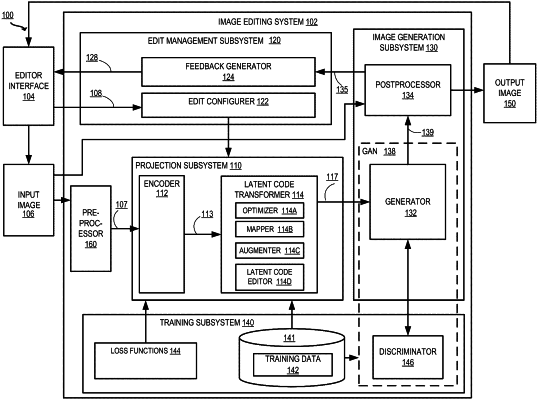| CPC G06N 3/08 (2013.01) [G06F 3/04845 (2013.01); G06F 3/04847 (2013.01); G06F 18/211 (2023.01); G06F 18/214 (2023.01); G06F 18/2163 (2023.01); G06F 18/40 (2023.01); G06N 3/045 (2023.01); G06N 20/20 (2019.01); G06T 3/0006 (2013.01); G06T 3/0093 (2013.01); G06T 3/40 (2013.01); G06T 3/4038 (2013.01); G06T 3/4046 (2013.01); G06T 5/005 (2013.01); G06T 5/20 (2013.01); G06T 11/001 (2013.01); G06T 11/60 (2013.01); G06T 2207/10024 (2013.01); G06T 2207/20081 (2013.01); G06T 2207/20084 (2013.01); G06T 2207/20221 (2013.01); G06T 2210/22 (2013.01)] | 20 Claims |

|
1. A computer-implemented method comprising:
cropping, by a computing system, an input image around a region to be edited to produce a cropped input image;
applying, by the computing system, an affine transformation to the cropped input image to produce a rotated cropped input image;
providing, by the computing system, the rotated cropped input image as input to a machine learning model to generate a latent space representation of the rotated cropped input image;
editing, by the computing system, the latent space representation to generate an edited latent space representation;
providing, by the computing system, the edited latent space representation as input to a trained generator neural network implemented by the computing system;
generating, by the generator neural network, a generated edited image;
applying, by the computing system, an inverse affine transformation to the generated edited image to generate a rotated generated edited image;
aligning, by the computing system, an identified segment of the rotated generated edited image with an identified corresponding segment of the input image to produce an aligned rotated generated edited image; and
blending, by the computing system, the aligned rotated generated edited image with the input image to generate an edited output image.
|